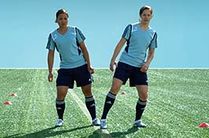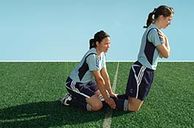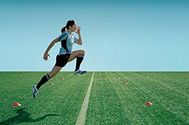The Fédération Internationale de Football Association FIFA 11+
This article or area is currently under construction and may only be partially complete. Please come back soon to see the finished work! (18/07/2019)
Original Editor - Your name will be added here if you created the original content for this page.
Top Contributors - LUCY INYANG EDET, Mathius Kassagga, Kim Jackson and Vidya Acharya
Objective[edit | edit source]
The International Federation of Association Football FIFA 11+ is complete warm-up programme specifically created in 2006 to prevent injuries in amateur football players. The programme also provides an injury-prevention model for other sports [1]. The programme was developed by FIFA's Medical Assessment and Research Centre (F-MARC) in cooperation with Santa Monica Sports Medicine Foundation (SMSMF), and the Oslo Sports Trauma and Research Centre (OSTRC)[2] to expand the knowledge-base on previous injury-prevention efforts, such as PEP (Prevent injury, Enhance Performance) programme and FIFA 11.
Intended Population[edit | edit source]
Method of Use[edit | edit source]
The programme takes twenty minutes to complete and is designed to be performed twice a week. No specific equipment is needed. The “11+” has three parts with a total of 15 exercises which should be performed in the specified sequence at the start of each training session. These are:
Part 1: running exercises at a slow speed combined with active stretching and controlled partner contacts. It encompasses cutting, change of direction, decelerating and proper landing techniques:
Part 2: six sets of exercises focusing on core and leg strength, balance and plyometrics/ agility, each with three levels of increasing difficulty. Focus on core strength, eccentric control and proprioception.
Part 3: running exercises at moderate / high speed combined with planting / cutting movements. High-speed and change-of-direction running
There are three levels for each specific exercise (level 1, level 2, level 3) that increase the difficulty of each respective exercise. This allows for both individual and team progression throughout the course of the competitive season.
More traditional football warm-up programmes are quite variable and typically encompass running exercises, static and/or dynamic stretching, movements involving change of direction, and short passing. They typically average from five to 45 minutes in duration. The average warm-up programme does not typically emphasis qualitative movement.
A key point in the programme is to use the proper technique during all of the exercises. pay full attention to correct posture and good body control, including straight leg alignment, knee-over-toe position and soft landing.
How to teach FIFA 11+[edit | edit source]
It is advisable to start with highlighting the importance of injury prevention to all players. After which, the explanation and instruction of the exercises. The key for efficient teaching is to start at level 1 and focus on how to perform the exercises correctly. carefully correct all mistakes! good body positioning is crucial. This allows for better neuromuscular work and a more efficient training session. when the players are able to perform the exercises correctly, the duration and the number of repetitions can be raised to the proposed intensity. The following steps are helpful in teaching a single exercise:
1. Explain briefly and demonstrate one exercise
2. Instruct the players to practise the exercise and give general feedback/corrections
3. Discuss some of the problems with all of the players, and then demonstrate the exercise again (maybe with one player who performs it well)
4. Instruct the players to perform the exercise again, and give individual feedbacks / corrections.
This method is particularly recommended for the six exercises in part 2. The running exercises in parts 1 and 3 may need less explanation and consequently less learning time. usually, it will take a minimum of 2–3 training sessions until the players are able to perform all exercises of the “11+” (level 1) correctly.
Progression to the next level[edit | edit source]
Football players should begin with level 1. only when an exercise can be performed without difficulty for the specified duration and number of repetitions should the player progress to the next level of this exercise.
There are three options:
1. Ideally, progression to the next level is determined individually for each player.
2. Alternatively, all players can progress to the next level for some exercises but continue with the current level for other exercises.
3. For simplicity, all players can progress to the next level of all exercises after three or four weeks.
Correct performance is of great importance for all exercises. Therefore the coach and physiotherapist should supervise the programme and correct the players if necessary.
Evidence[edit | edit source]
Reliability[edit | edit source]
Validity[edit | edit source]
Responsiveness[edit | edit source]
Miscellaneous[edit | edit source]
Links[edit | edit source]
References[edit | edit source]
- ↑ Thorborg K, Krommes KK, Esteve E, Clausen MB, Bartels EM, Rathleff MS. Effect of specific exercise-based football injury prevention programmes on the overall injury rate in football: a systematic review and meta-analysis of the FIFA 11 and 11+ programmes. Br J Sports Med. 2017 Apr 1;51(7):562-71.
- ↑ Bizzini M, Dvorak J. FIFA 11+: an effective programme to prevent football injuries in various player groups worldwide—a narrative review. Br J Sports Med. 2015 May 1;49(9):577-9.










